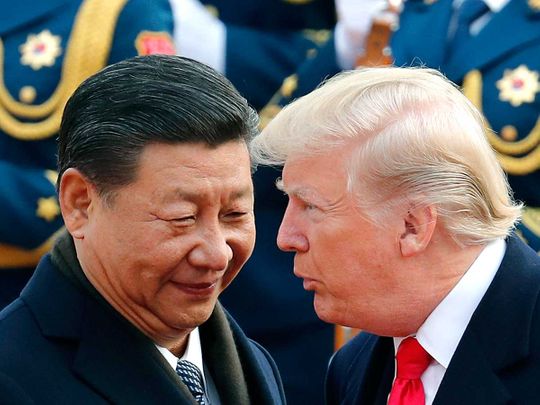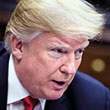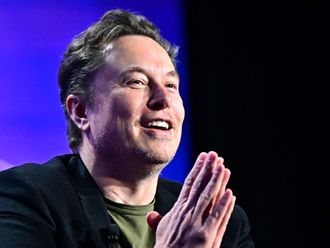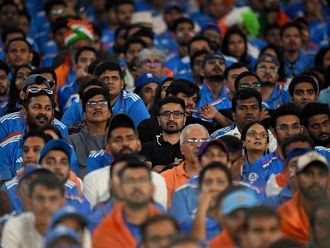
United States President Donald Trump is making final preparations for a multi-day trip to Japan which starts later this week. The White House is currently facing into significant international challenges from Venezuela to Iran. Yet, it is Asia that looms potentially largest after recent setbacks in the trade talks with China, and the impasse in nuclear diplomacy with North Korea.
In recent days, it is the Washington-Beijing negotiations that have hit the headlines after Donald Trump last week increased tariffs on some $200 billion (Dh735.6 billion) on Chinese goods from 10 per cent to 25 per cent. Beijing punched back by announcing it will also up the ante by setting new tariffs of between 5 per cent and 25 per cent on $60 billion of US imports which will kick on June 1.
While both sides had wanted to do a deal at or before next month’s G20 in Japan next month, this goal is now much more uncertain. To be sure, the talks have made significant progress, with both sides poring over a reportedly 150-page document. While Beijing has denied it, Trump asserts that the main blockage to a deal — which he said last Monday is “95 per cent done” — is China backtracking on provisions previously agreed on issues like state subsidies, intellectual property rights and currency manipulation.

“China ... has been very tough on our country ... We probably lost last year $500 billion in trade to China”.
Given Trump’s mercurial nature, it remains possible that the current impasse is merely a prelude to a deal being agreed upon soon that he will shower in superlatives like the “greatest agreement ever”. However, there is a growing chance that the talks will fall down which could herald a more unpredictable phase in relations between the world’s two most powerful states.
Here, Beijing is well aware there remains the possibility that Trump’s rhetoric will get very hostile again, as during much of 2016 and 2017. He has previously asserted that “China ... has been very tough on our country ... We probably lost last year $500 billion in trade to China”.
And it is this narrative that Trump may yet return to if he judges it again in his political interests, especially in the context of his anticipated 2020 re-election campaign and fulfilling his ‘Make America Great Again’ pledge. This includes seeking to reduce the US global trade deficit and cracking down on trade practices perceived to be unfair.
It is conceivable, in relation to China, that the president could claim to have delivered this agenda by ‘being tough’ on Beijing with tariffs rather than showcasing a new trade deal. Earlier this month, he rehearsed these arguments asserting that China “broke the deal ... They can’t do that. So they’ll be paying ... nothing wrong with taking in more than $100 billion a year [in tariffs]”.
Yet, it is not just Washington’s diplomacy with China that is now much more uncertain, but also with Pyongyang too. Earlier this month, the North Korean regime completed its second missile test in less than a week.
And this comes after the US-North Korea summit in Vietnam in February ended in a diplomatic disaster, after months of painstaking negotiations were expected to yield a deal, when Trump “walked” out from talks with Kim Jong-un. To be sure, there are historical precedents for such high-profile negotiations to fall down, and then recover, including the US-Soviet negotiations between Ronald Reagan and Mikhail Gorbachev in 1986 and 1987.
However, it appears the gaps between Trump and Kim remain substantial. And the North Koreans have asserted post-Vietnam that they will not change their position, and also disputed Trump’s account that the reason the talks collapsed was that Pyongyang asked for full sanctions rollback.
If the talks are to rejuvenate, it is likely that outside powers such as China and Russia will have to row in too to put pressure on North Korea. And it is here that Trump finds himself in a bind given the flailing trade negotiations with Beijing.
Part of the reason Kim originally came to the negotiating table in 2018 was the tightening of the screws by neighbouring China on him, especially on the trade front. Yet, especially if a new chill develops between Washington and Beijing, the latter will have less incentive to assist, not least given its long-standing reluctance anyway to take too sweeping measures against Pyongyang for fear about squeezing it so hard that it becomes significantly destabilised. With Trump’s latest Asia trip on the horizon, any decisive breakthrough in US-China talks may now require the personal intervention of Trump and Xi at the G20 in Japan, or a special summit in China or the US. Failure to secure a trade agreement will not just be a setback for bilateral relations, but also undermine other US goals in the region, including prospects of getting North Korean diplomacy back on track.
Andrew Hammond is an Associate at LSE IDEAS at the London School of Economics.









